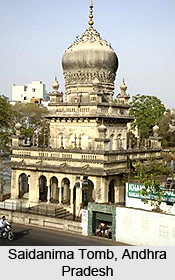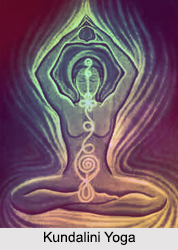 Kundalini Yoga is a mental, physical and spiritual discipline constructed around the meditative and physical techniques which were found in the teachings of Shakti Yoga, Raja Yoga, Bhakti Yoga, Kriya Yoga, Tantra Yoga, Nada Yoga, Laya Yoga and the principles and sutras of Patanjali. Kundalini Yoga is a form of meditative and physical yoga which comprises of several techniques by using the body, mind and senses and the result received is a relaxing and peaceful communication between the body and the soul.Kundalini Yoga provides special concern to the function of the endocrine system and the spine, which form a vital part in yogic awakening. This yoga puts stress on the spiritual and psychological growth and the capability of body in order to attain maturity. The chakras or psychic centers inside the human body are regarded as the center for generating spiritual power and this power is known as Kundalini energy. The life force or Prana is believed to be in a dormant state in the human body. Kundalini is the budding form of prana. It is the force preserved in the shape of a coiled serpent and this serpent is believed to take rest in a dormant state inside Mooladhara Chakra.Etymology of Kundalini Yoga
Kundalini Yoga is a mental, physical and spiritual discipline constructed around the meditative and physical techniques which were found in the teachings of Shakti Yoga, Raja Yoga, Bhakti Yoga, Kriya Yoga, Tantra Yoga, Nada Yoga, Laya Yoga and the principles and sutras of Patanjali. Kundalini Yoga is a form of meditative and physical yoga which comprises of several techniques by using the body, mind and senses and the result received is a relaxing and peaceful communication between the body and the soul.Kundalini Yoga provides special concern to the function of the endocrine system and the spine, which form a vital part in yogic awakening. This yoga puts stress on the spiritual and psychological growth and the capability of body in order to attain maturity. The chakras or psychic centers inside the human body are regarded as the center for generating spiritual power and this power is known as Kundalini energy. The life force or Prana is believed to be in a dormant state in the human body. Kundalini is the budding form of prana. It is the force preserved in the shape of a coiled serpent and this serpent is believed to take rest in a dormant state inside Mooladhara Chakra.Etymology of Kundalini Yoga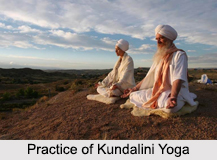 In Sanskrit language, the term ‘Kundalini’ literally means something that is coiled. It is considered to be taking rest at the basal portion of human’s spine and can awake and spring up when excited by the disciplines of spirituality known as ‘Kundalini Yoga’.Importance of Kundalini YogaKundalini Yoga practice consists of several bodily postures, utterances, expressive movements and breathing patterns, characterological cultivations and the levels of concentration. Like various other yoga forms, Kundalini Yoga also relates movement along with breath. The way it varies is its direct focus on the movement of energy through the system of chakra, motivating energy in the chakras of the lower portion and moving the same to the higher chakras. This Yoga wakes up the energy which resides in a dormant state in the spine. Even if Kundalini Yoga is greatly a physical pattern of yoga, the major benefit from it is received by the inner experience. Famously called the ‘Yoga of Awareness’, this yoga arouses the unlimited capability which exists there inside all individuals. When the unlimited potential is roused in the human body, it provides raised intuition and clarity of mind as well as the potential for creativeness. In Kundalini Yoga, the sustaining and creating Shakti of the entire body is truly and actually unified with Lord Shiva. The awakening of Kundalini Shakti and Her subsequent Union with Lord Shiva impacts the Samadhi state or Ecstatic union and spiritual experience or Anubhava.
In Sanskrit language, the term ‘Kundalini’ literally means something that is coiled. It is considered to be taking rest at the basal portion of human’s spine and can awake and spring up when excited by the disciplines of spirituality known as ‘Kundalini Yoga’.Importance of Kundalini YogaKundalini Yoga practice consists of several bodily postures, utterances, expressive movements and breathing patterns, characterological cultivations and the levels of concentration. Like various other yoga forms, Kundalini Yoga also relates movement along with breath. The way it varies is its direct focus on the movement of energy through the system of chakra, motivating energy in the chakras of the lower portion and moving the same to the higher chakras. This Yoga wakes up the energy which resides in a dormant state in the spine. Even if Kundalini Yoga is greatly a physical pattern of yoga, the major benefit from it is received by the inner experience. Famously called the ‘Yoga of Awareness’, this yoga arouses the unlimited capability which exists there inside all individuals. When the unlimited potential is roused in the human body, it provides raised intuition and clarity of mind as well as the potential for creativeness. In Kundalini Yoga, the sustaining and creating Shakti of the entire body is truly and actually unified with Lord Shiva. The awakening of Kundalini Shakti and Her subsequent Union with Lord Shiva impacts the Samadhi state or Ecstatic union and spiritual experience or Anubhava.
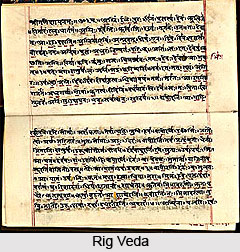 Vedic literature glorifies Vedic India. ‘Vedas’, a Sanskrit phrase, implies knowledge. It is the traditional faith that Vedas are ‘apuruseya’ (not composed by human beings), which was known to be a direct revelation of God, hence named shruti. Scholars believed that Vedic Literature originates long before the literary tradition started in India. However the oldest text, Rig-Veda has been traced back to the 11th century. The Vedic literature consists of the Vedas, Upanishads, Vedangas, Sutras, Upavedas, Shastras and Puranas.The Vedic period lasted for a millennium encompassing the late bronze & Iron Age. As far as the researches are concerned, the Vedic Literatures are composed in 1500 B.C, over a period of years. Vedic Literature saw its crest after the composition of the mantra texts, frequently called Samhita texts. With the composition of the mantra texts, shakas were established all over northern India. Usually Shakas are the theological schools that were focused on the learning of the Vedic Mantras.The Vedas can be classified into categories of texts, traditionally the Samhitas or mantras, Brahmans, Aryanyak and Upanishads. The Vedas, as often termed as the Sutra literature can also be classified into Shrautasutras and Grahyasutras.The Vedic Samhitas or the Mantras are mainly the metric texts and there are four Vedic samhitas- Rig Veda, Sama Veda, Yajur Veda and Atharva Veda. Sometimes the term ‘Vedas’ is used to signify those Samhitas. The Samhitas are the oldest stratum of Vedic texts. As ‘Vedic Concordance’ of Bloomfield, an eminent scholar records, Vedas have 89000 padas, of which 72000 are in Samhitas.
Vedic literature glorifies Vedic India. ‘Vedas’, a Sanskrit phrase, implies knowledge. It is the traditional faith that Vedas are ‘apuruseya’ (not composed by human beings), which was known to be a direct revelation of God, hence named shruti. Scholars believed that Vedic Literature originates long before the literary tradition started in India. However the oldest text, Rig-Veda has been traced back to the 11th century. The Vedic literature consists of the Vedas, Upanishads, Vedangas, Sutras, Upavedas, Shastras and Puranas.The Vedic period lasted for a millennium encompassing the late bronze & Iron Age. As far as the researches are concerned, the Vedic Literatures are composed in 1500 B.C, over a period of years. Vedic Literature saw its crest after the composition of the mantra texts, frequently called Samhita texts. With the composition of the mantra texts, shakas were established all over northern India. Usually Shakas are the theological schools that were focused on the learning of the Vedic Mantras.The Vedas can be classified into categories of texts, traditionally the Samhitas or mantras, Brahmans, Aryanyak and Upanishads. The Vedas, as often termed as the Sutra literature can also be classified into Shrautasutras and Grahyasutras.The Vedic Samhitas or the Mantras are mainly the metric texts and there are four Vedic samhitas- Rig Veda, Sama Veda, Yajur Veda and Atharva Veda. Sometimes the term ‘Vedas’ is used to signify those Samhitas. The Samhitas are the oldest stratum of Vedic texts. As ‘Vedic Concordance’ of Bloomfield, an eminent scholar records, Vedas have 89000 padas, of which 72000 are in Samhitas.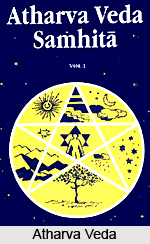 The Rig Veda: This oldest existing Indian text is an anthology of 1028 hymns and 10,600 verses devoted to the Rig Vedic deities, compiled in 10 mandalas or books. According to the different opinions forwarded by the historians, saints composed Rig Veda for a period of 500 years in the Sapta – Sindhu, present day Punjab region of Indian Subcontinent. The Indian Rig Veda is closely synonymous with the Iranian and Andronovo culture.The Sama Veda: The name ‘Sama’ derived from the word ‘saman’ means the ‘song of praise’. The Sama Veda is the ‘Veda of chants’ or ‘Knowledge of melodies’. Sama Veda is a compilation of 1875 verses, some of which are the repetitive imitations of the Rig Veda. It serves as a song book for the priests who take part in public worship. A priest singing in the rituals is commonly called ‘udgati’ or ‘cantor’. A fixed style was followed by the priests while enchanting. Two major shakas are associated with this Veda- Ranayianiya and Jainimiya.The Yajur Veda: It consists of cryptic prose mantras, some parts are borrowed from the Rig Veda. Each of the mantras in the Yajur Veda are associated with specific sacrificial rites, not merely Soma offering. Two major recessions of the Yajur Veda are "White" & "Black". The "White" discusses only those verses required for the sacrifices but do not explain the implication of those verses but the "black" Yajurveda contain specific explanations of the work to be performed.The Atharva Veda: depicts the "Knowledge of the Atharvans" or the "Agnisara". As it has been pointed by Apte, the scholarly historian, "atharvan" is a priest who worships fire and Soma. It is a collection of 760 hymns and about one-sixth hymns are the imitation of Rig Veda. The Atharva Veda has least connection with the sacrifices and rituals but involves the incantations required for prevention of demons and disasters.
The Rig Veda: This oldest existing Indian text is an anthology of 1028 hymns and 10,600 verses devoted to the Rig Vedic deities, compiled in 10 mandalas or books. According to the different opinions forwarded by the historians, saints composed Rig Veda for a period of 500 years in the Sapta – Sindhu, present day Punjab region of Indian Subcontinent. The Indian Rig Veda is closely synonymous with the Iranian and Andronovo culture.The Sama Veda: The name ‘Sama’ derived from the word ‘saman’ means the ‘song of praise’. The Sama Veda is the ‘Veda of chants’ or ‘Knowledge of melodies’. Sama Veda is a compilation of 1875 verses, some of which are the repetitive imitations of the Rig Veda. It serves as a song book for the priests who take part in public worship. A priest singing in the rituals is commonly called ‘udgati’ or ‘cantor’. A fixed style was followed by the priests while enchanting. Two major shakas are associated with this Veda- Ranayianiya and Jainimiya.The Yajur Veda: It consists of cryptic prose mantras, some parts are borrowed from the Rig Veda. Each of the mantras in the Yajur Veda are associated with specific sacrificial rites, not merely Soma offering. Two major recessions of the Yajur Veda are "White" & "Black". The "White" discusses only those verses required for the sacrifices but do not explain the implication of those verses but the "black" Yajurveda contain specific explanations of the work to be performed.The Atharva Veda: depicts the "Knowledge of the Atharvans" or the "Agnisara". As it has been pointed by Apte, the scholarly historian, "atharvan" is a priest who worships fire and Soma. It is a collection of 760 hymns and about one-sixth hymns are the imitation of Rig Veda. The Atharva Veda has least connection with the sacrifices and rituals but involves the incantations required for prevention of demons and disasters.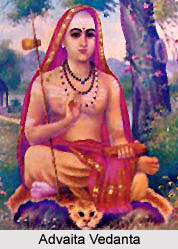 The Brahmanas are the prose literature, codified in a procedural fashion, which depicts the sacrificial rituals, their meanings and a complete commentary on the usage, implication and their significant effect of those rituals. Brahmanas are considered to be the heart of Indian Philosophy, describing the concepts of Karma and Samsara and the significance of the four stages of the life of a Hindu Brahmin, namely- Brahmacharya, Grihasthya and Vanprastha and Sanyas. It also provides a perception of the spirituality and supernaturalism of the Vedanta philosophy. Each of the Brahmans are associated with one of the Samhitas and according to that one of the shakas or schools. The Brahmans may also include the Aryanaka or the Upanishads.
The Brahmanas are the prose literature, codified in a procedural fashion, which depicts the sacrificial rituals, their meanings and a complete commentary on the usage, implication and their significant effect of those rituals. Brahmanas are considered to be the heart of Indian Philosophy, describing the concepts of Karma and Samsara and the significance of the four stages of the life of a Hindu Brahmin, namely- Brahmacharya, Grihasthya and Vanprastha and Sanyas. It also provides a perception of the spirituality and supernaturalism of the Vedanta philosophy. Each of the Brahmans are associated with one of the Samhitas and according to that one of the shakas or schools. The Brahmans may also include the Aryanaka or the Upanishads.
For more visit the page:
 Indian Film Festivals over the years, is gaining immense popularity among the people of India and around the world as well.Foreign people have started to take notice of the films that are made in India and they come in large numbers to be a part of the Indian Film Festivals. Over the years, and especially in the two decades, the Indian Film Industry has grown leaps and bounds.
Indian Film Festivals over the years, is gaining immense popularity among the people of India and around the world as well.Foreign people have started to take notice of the films that are made in India and they come in large numbers to be a part of the Indian Film Festivals. Over the years, and especially in the two decades, the Indian Film Industry has grown leaps and bounds.
Origin of Film Festivals in IndiaThe beginning of the film festivals in India can be traced to the stupendous rise of the cine-clubs and film societies that sprang up at various parts of the country during the 1950's, mainly in Delhi, Mumbai, Kolkata and few other places in south India. The urge to set up cine clubs was seen as an effect of the rise Hollywood film industry, and over non-commercial movements dedicated to such causes as documentary and avant-garde film. Such societies and clubs popularized across the country, where they promoted the materialization of the historically important surrealist and impressionist cinemas, where they provided the only regular outlet for domestically produced movies. As such cine clubs grew and spread across India, they went ahead to organize international conclaves where their members, many of whom were aspiring filmmakers, could share thoughts, ideas and inspirations without any regard to national borders. Activities such as these were the prototypes and predecessors of film festivals.Lists of Film Festivals in IndiaIndian Movies consists of films produced across the country, which includes the cinematic customs, tradition and cultures of various states like; Andhra Pradesh, Haryana, Jammu and Kashmir, Assam, Gujarat, Karnataka, Kerala, Punjab, Tamil Nadu, Maharashtra, Orissa and West Bengal. Indian movies are now being closely followed throughout Middle East and South Asia, and in parts of Europe. Cinema, as a medium of entertainment, has gained reputation in the India. And now we see as many as 1,000 films in a variety of Indian languages are produced every year.
Such societies and clubs popularized across the country, where they promoted the materialization of the historically important surrealist and impressionist cinemas, where they provided the only regular outlet for domestically produced movies. As such cine clubs grew and spread across India, they went ahead to organize international conclaves where their members, many of whom were aspiring filmmakers, could share thoughts, ideas and inspirations without any regard to national borders. Activities such as these were the prototypes and predecessors of film festivals.Lists of Film Festivals in IndiaIndian Movies consists of films produced across the country, which includes the cinematic customs, tradition and cultures of various states like; Andhra Pradesh, Haryana, Jammu and Kashmir, Assam, Gujarat, Karnataka, Kerala, Punjab, Tamil Nadu, Maharashtra, Orissa and West Bengal. Indian movies are now being closely followed throughout Middle East and South Asia, and in parts of Europe. Cinema, as a medium of entertainment, has gained reputation in the India. And now we see as many as 1,000 films in a variety of Indian languages are produced every year.
For more visit the page:
Tombs in India were generally dedicated to the Muslim rulers who ruled India for centuries. Basically, there was no indigenous tradition of building tomb in India. The ashes of the dead were carried away by the sacred rivers. Even in Islam, tomb building was restricted. The building of tomb to glorify a grave by constructing a building over it was forbidden for centuries, as this would run counter to the equality of all men in death. By the time of the Muslim invasions of India in the 12th century, the proscription against tomb building was extensively ignored. In India a Muslim tomb or 'qabristan' mainly comprises a single vaulted domed chamber, in the centre of which is the cenotaph. Below lays the mortuary chamber or maqbara, with the grave or 'qabr' in the centre. Occasionally, the west wall possesses a 'mihrab'. Often some bigger tombs have mosques attached as separate buildings, the whole ensemble being contained within an enclosure or garden and called a 'rauza'.
For more read:
The History of West Bengal reveals that it was divided into many small states. The Buddhist and Jaina works and the coins prove that towards the middle of the sixth century B.C. independent sovereign states were established in Vanga and Radha. However in the beginning of the fourth century B.C., a state called Gangaridai as arose out of the unison of lower and western Bengal. The Bhagavata Purana discusses the primitive people of Bengal as sinners because they were considered Dasyus and not Indo Aryans. But the Vanga and Anga in Bengal are identified as Indo-Aryans in the Jain scriptures. The remains of the settlements of the Copper Age suggest that the region of Bengal dates back to four thousand years. Earliest evidences of human settlements are derived from the stone tools and such pre historic stone tools have been found in many regions of Bengal such as Medinipur, Bankura and Bardhaman. In the Mahabharata there are references of Bengali kings like Chitrasena who was defeated by Bhima. The epic also suggests that Bengal was divided among various tribes or kingdoms such as southern, northern and western Bengal. Western Bengal was a part of Magadha. However it was under the Nanda Empire that the whole of Bengal came under the Indo Aryan rule. According to belief Gangaridai was a part of King Ashoka's Empire. During the rule of the Kushanas the major part of the state was ruled by three agents. Over a period of time these rulers refused to accept the suzerainty of the Kushanas and thereby became independent. This was followed by a period of uncertainty and turmoil. According to an inscription Simha Varman and his son Chandra Varman were the rulers of Bengal when the Guptas had come to power (319-20 A.D.). As per the Allahabad Stone Pillar inscription Samatata was a part of Samudragupta's kingdom. The inscription gives evidence that North Bengal was included within the Gupta Empire.
According to belief Gangaridai was a part of King Ashoka's Empire. During the rule of the Kushanas the major part of the state was ruled by three agents. Over a period of time these rulers refused to accept the suzerainty of the Kushanas and thereby became independent. This was followed by a period of uncertainty and turmoil. According to an inscription Simha Varman and his son Chandra Varman were the rulers of Bengal when the Guptas had come to power (319-20 A.D.). As per the Allahabad Stone Pillar inscription Samatata was a part of Samudragupta's kingdom. The inscription gives evidence that North Bengal was included within the Gupta Empire.
For more visit the page:
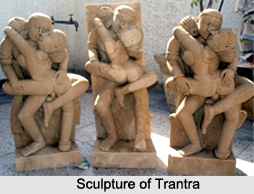 Tantrism has persisted and thrived throughout Asian history since the middle of the first millennium. It deals with spiritual practices and ritual forms of worship aiming at liberation from ignorance and rebirth. The universe is regarded as the godly play of Shakti and Shiva. Tantrism developed into a tradition by the end of the Gupta reign. However it has influenced major religions like Hinduism, Sikhism, Buddhism and Jainism. Tantrism is characterized by the use of rituals thereby identifying macrocosm and microcosm. In Tantrism one uses the heavenly power that flows through the universe to achieve certain goals.Origin of TantrismOrigin of Tantrism is a debatable issue. There are diverse views - some say that the Pre-Aryan Indians could have been the discoverers; others consider it as the tradition of ancient people. Historically it dates back to the time of the rise of the religion of Buddhism as the later Buddhists adopted some of the Tantric symbols.Relation to Vedic TraditionThe tradition of Tantrism may be considered as intertwined with the Vedic tradition. The sources of written Tantric tradition are the agama which consists of four parts describing jnana, yoga, kriya and charya. Elements of Tantrism exist in Shaiva, Vaishnava, Ganapatya, Shaurya and Shakta forms. The basic ideas of Tantra as a philosophy are found in the Rig Veda. Tantrism is a build-up of various resources to change mundane into super mundane. There are some hymns and use of mystic words during the Rig Vedic period which proves the origin of Tantra.
Tantrism has persisted and thrived throughout Asian history since the middle of the first millennium. It deals with spiritual practices and ritual forms of worship aiming at liberation from ignorance and rebirth. The universe is regarded as the godly play of Shakti and Shiva. Tantrism developed into a tradition by the end of the Gupta reign. However it has influenced major religions like Hinduism, Sikhism, Buddhism and Jainism. Tantrism is characterized by the use of rituals thereby identifying macrocosm and microcosm. In Tantrism one uses the heavenly power that flows through the universe to achieve certain goals.Origin of TantrismOrigin of Tantrism is a debatable issue. There are diverse views - some say that the Pre-Aryan Indians could have been the discoverers; others consider it as the tradition of ancient people. Historically it dates back to the time of the rise of the religion of Buddhism as the later Buddhists adopted some of the Tantric symbols.Relation to Vedic TraditionThe tradition of Tantrism may be considered as intertwined with the Vedic tradition. The sources of written Tantric tradition are the agama which consists of four parts describing jnana, yoga, kriya and charya. Elements of Tantrism exist in Shaiva, Vaishnava, Ganapatya, Shaurya and Shakta forms. The basic ideas of Tantra as a philosophy are found in the Rig Veda. Tantrism is a build-up of various resources to change mundane into super mundane. There are some hymns and use of mystic words during the Rig Vedic period which proves the origin of Tantra.
Ranji Trophy was started in the 1934-1935 season, after the Indian board met and decided to launch a domestic tournament for the Indian cities and states.History of Ranji TrophyRanji Trophy was named after KS Ranjitsinhji, the Prince of Nawanagar, who played for Sussex and also played for England between 1896 and 1902. He was also popularly known as Ranji. The Ranji Trophy is considered to be India's equivalent to county cricket in England and the Pura Cup competition held in Australia. H.H. Sir Bhupendra Singh Mahinder Bahadur, the Maharajah of Patiala, donated the champions' trophy of the first season of the tournament.Format of Ranji Trophy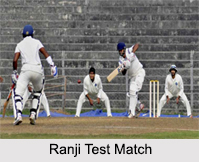 According to the format of the Ranji Trophy in the initial period, the teams first participated in knockout rounds and then reached a timeless final. The rules stated that in case of draws, the team leading in the first innings was announced as the winner. However, the rules were changed and zonal groups introduced, in 1957-58 after a spate of matches where sides with no chance of winning conceded. According to the changed format, the teams were divided into the 5 zones like North, West, East, Central and South. Teams in zone played each other in the league stage. The top 2 teams (till 1991-92) and top 3 following them from the zones played each other in the knockout round through which the eventual winner was decided. However, the format was changed in the 2002-03 season, when the elite and the plate divisions came into play. The BCCI changed the names of the elite and plate divisions to 'Super League' and 'Plate League' in the 2006-07 season. Though most of the teams in the tournament represent the different states of India, Maharashtra, Mumbai, Gujarat and Vadodara, have separate teams. However, besides the states, the teams like Railways and Services also participate in the Ranji Trophy.
According to the format of the Ranji Trophy in the initial period, the teams first participated in knockout rounds and then reached a timeless final. The rules stated that in case of draws, the team leading in the first innings was announced as the winner. However, the rules were changed and zonal groups introduced, in 1957-58 after a spate of matches where sides with no chance of winning conceded. According to the changed format, the teams were divided into the 5 zones like North, West, East, Central and South. Teams in zone played each other in the league stage. The top 2 teams (till 1991-92) and top 3 following them from the zones played each other in the knockout round through which the eventual winner was decided. However, the format was changed in the 2002-03 season, when the elite and the plate divisions came into play. The BCCI changed the names of the elite and plate divisions to 'Super League' and 'Plate League' in the 2006-07 season. Though most of the teams in the tournament represent the different states of India, Maharashtra, Mumbai, Gujarat and Vadodara, have separate teams. However, besides the states, the teams like Railways and Services also participate in the Ranji Trophy.
Yoga Asana traditionally means a 'sitting condition' or 'position' of the body, which contributes to the steadiness of the body and mind and a sense of well-being. In a nutshell, the yoga asanas can be defined as postural patterns. Asanas are also based on the natural postures of various animals, birds or even symbols like the tree, lotus, bow and plough, etc. Yoga asanas include various types of sitting, standing, stretching and inverted postures all aimed to improve flexibility, balance, strength and posture. These Yoga asanas target various muscle groups in the body. Some yoga asanas are highly ancient and have been mentioned in several ancient yoga texts.History of Yoga AsanasThough it was Maharishi Patanjali, who for the first time mentions yoga asanas, the history of these postural patterns goes back even earlier than the days of Patanjali. There are references in the Vedas, Brahmanas, Aranyakas and the earlier Upanishads about these practices. Besides, Lord Shiva and the Buddha are often portrayed sitting in the Padmasana; thus, indicating that yoga asanas were practised in ancient India as well.Types of Yoga AsanasYoga asanas can be classified by considering their features and effects, into three major groups, and one minor group that contains only two asanas. Of the major three, the classification into cultural asanas and meditative asanas is a contemporary innovation.
 Kundalini Yoga is a mental, physical and spiritual discipline constructed around the meditative and physical techniques which were found in the teachings of Shakti Yoga, Raja Yoga, Bhakti Yoga, Kriya Yoga, Tantra Yoga, Nada Yoga, Laya Yoga and the principles and sutras of Patanjali. Kundalini Yoga is a form of meditative and physical yoga which comprises of several techniques by using the body, mind and senses and the result received is a relaxing and peaceful communication between the body and the soul.
Kundalini Yoga is a mental, physical and spiritual discipline constructed around the meditative and physical techniques which were found in the teachings of Shakti Yoga, Raja Yoga, Bhakti Yoga, Kriya Yoga, Tantra Yoga, Nada Yoga, Laya Yoga and the principles and sutras of Patanjali. Kundalini Yoga is a form of meditative and physical yoga which comprises of several techniques by using the body, mind and senses and the result received is a relaxing and peaceful communication between the body and the soul. In Sanskrit language, the term ‘Kundalini’ literally means something that is coiled. It is considered to be taking rest at the basal portion of human’s spine and can awake and spring up when excited by the disciplines of spirituality known as ‘Kundalini Yoga’.
In Sanskrit language, the term ‘Kundalini’ literally means something that is coiled. It is considered to be taking rest at the basal portion of human’s spine and can awake and spring up when excited by the disciplines of spirituality known as ‘Kundalini Yoga’.





